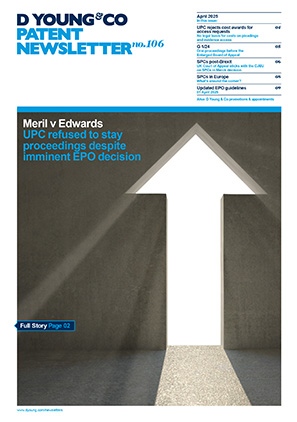Preliminary injunctions before the Unified Patent Court: what do we know so far?
Preliminary injunctions (PIs) have long been an attractive remedy in patent infringement actions as a means to stop alleged infringing activities on a provisional basis, pending full trial.
It was therefore no surprise to stakeholders when the Agreement on a Unified Patent Court (UPCA) and associated Rules of Procedure (RoP) of the new Unified Patent Court (UPC) were drafted to contain provisions relating to provisional measures, including preliminary injunctions (Article 62(1), UPCA and Rule 205, RoP).
Prior to the UPC opening its doors in June 2023, patent proprietors wishing to obtain preliminary injunctions in Europe were restricted to making individual applications before national courts. Different national courts have tended to apply different criteria to the issuance of preliminary injunctions. Therefore, obtaining multiple preliminary injunctions in different countries has historically been a costly and complicated exercise, requiring careful strategic planning.
The UPC has exclusive jurisdiction over European patents with unitary effect in addition to classical European patents which have not been specifically “opted-out” of the UPC jurisdiction. The UPC may therefore grant provisional remedies, including PIs, on a pan-European basis in those seventeen countries that are party to the UPCA. The ability to obtain a PI in multiple European countries via a single application to the UPC has the potential to be both a cost-effective and powerful legal remedy.
Unsurprisingly then, a number of preliminary injunction applications have already been brought before the UPC, and it is interesting to see the early approaches taken by the court in assessing the relative merits of each application.
myStromer AG v Revolt Zycling AG
In myStromer AG v Revolt Zycling AG a preliminary injunction application was made on an ex parte basis to the Düsseldorf Local Division of the UPC. The patent in suit, EP24546134B, relates to a combination structure of a bicycle frame and a motor hub, that is, the main components of an e-bike. In this case, the alleged infringing product was not commercially available at the time of the preliminary injunction application, but evidence was adduced that it could be test ridden at a trade fair that had taken place between 21 and 25 June 2003. The patent proprietor unsuccessfully requested a cease and desist declaration from the defendant on 22 June 2023, and subsequently applied for an ex parte preliminary injunction, which was granted on the same day.
Interestingly, the defendant filed a protective letter which was considered by the court when deciding on the application. In the letter, the defendant claimed that the patent was invalid, that it was not infringed, and that the associated patent rights had been exhausted. However, in doing so, the defendant did not identify any prior art as being of particular relevance to the validity of the patent, nor did the letter contain any detailed reasoning as to why the e-bike in question did not infringe the patent, that is, the letter content was largely unsubstantiated. The court granted a preliminary injunction on the following grounds:
- The validity of the patent had been confirmed to the required extent because no opposition had been filed at the EPO, no revocation action had previously been brought before a national court, and the defendant had not. Identified any prior art of particular relevance to validity in their protective letter.
- The defendant’s e-bike product was found to infringe the claims of the patent in the literal sense and no substantive arguments regarding non-infringement had been put forward by the defendant.
- The application was urgent in light of the trade fair and exhibition of the alleged infringing product at the trade fair could lead to a loss of sales and market share for the patent proprietor that would be difficult to regain.
10x Genomics v NanoString
In the ongoing dispute between 10x Genomics v NanoString, before the Munich Local Division of the UPC, there have been two recent preliminary injunction applications for different European patents in the same family relating to compositions and methods for analyte detection.
In proceedings relating to a divisional patent, EP4108782B, the court granted a preliminary injunction following an inter partes hearing on 05-06 September 2023. The court considered the following substantive issues in considerable detail before deciding to grant the preliminary injunction:
- Competence of the Munich local division.
- Admissibility of the application for provisional measures, including formal requirements.
- Eligibility to sue: the legal standing of the parties.
- Patent claim interpretation.
- Patent validity: including, novelty, inventive step, sufficiency of disclosure and added subject matter.
- Presumption of patent validity and burden of proof to establish patent invalidity.
- Extent of infringement, including an assessment of both direct and contributory infringing acts.
- Licence claims of the defendants under US and EU antitrust provisions.
- Urgency of bringing the preliminary injunction application: unreasonable delay.
- Potential damages arising from infringing acts.
- Proportionality of granting an injunction.
The reasoned decision, which totals in excess of 100 pages, was issued by the court on 19 September 2023, just two weeks following the hearing. A strong signal of intent from the court that it is willing and able to consider complex technical and legal issues swiftly in the context of applications for provisional measures.
The second preliminary injunction application, relating to the parent patent, EP2794928B, was refused by the court following a similarly detailed assessment.
In refusing the application the court expressed concerns regarding the infringement and validity of the patent in question and also the apparent lack of urgency in bringing the preliminary injunction application. The court did, however, point out that these concerns would not prejudice the decision on the merits
What can we learn about provisional measures before the UPC from these early cases?
In the correct circumstances, it is possible to obtain provisional measures, including preliminary injunctions, very quickly (even the same day) and without the defendant having a right to be heard.
The decision to file a protective letter should be taken carefully. While a well-substantiated letter containing detailed arguments, relating to non-infringement and/or patent validity, is likely to mitigate the risk of a provisional measure being issued on an ex parte basis, an unsubstantiated letter will make it easier for the UPC to issue an ex parte remedy, on the basis that it has no conviction in the defendant’s lines of argument.
The UPC appears willing to take a “deep dive” into substantive legal and technical issues, including patent validity, within a short time frame during proceedings relating to provisional measures. Most observers were surprised by the comprehensiveness of the 10x Genomics decisions, which one might say the UPC has used to promote itself as a future forum of choice for litigants.
Although the UPC has shown itself to be capable of hearing preliminary injunction applications in a very prompt and comprehensive manner, it remains to be seen whether prospective litigants will view this favourably, or not.
Case details at a glance
Jurisdiction: UPC
Decision level: Court of First Instance, Düsseldorf (DE) Local Division
Parties: myStromer AG v Revolt Zycling AG
Order: ORD_526778/2023
Date: 18 October 2023
Case details at a glance
Jurisdiction: UPC
Decision level: Court of First Instance, Munich (DE) Local Division
Parties: NanoString Technologies Inc, NanoStrings Technologies Germany GmbH, NanoString Technologies Netherlands BV v 10x Genomics Inc, President and Fellows of Harvard College
Order: ACT_459746/2023
Date: 19 September 2023

